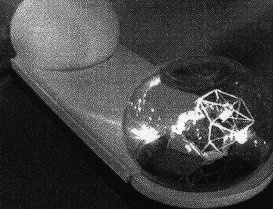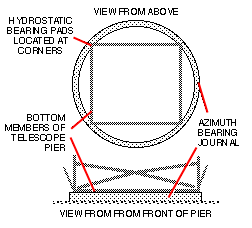|
Keck Telescope SCIENCE KIT
Presentation Guide

IDEAS FOR SCIENCE FAIRS, CLASSROOM USE, CLUB ACTIVITIES, ETC.
Purpose
This page shows suggestions for displaying your Keck Telescope Model, as well as supplementary information and references. Most people might prefer to keep their Keck Telescope model on a desk or bookshelf, or somewhere else in their home or office. These additional suggestions are provided for persons who want to use the model as part of a more realistic display at home, or at a school, planetarium, science museum, science fair, or other situation. The ideas on this sheet are presented as simple suggestions. Much improvement and more attention to detail is of course possible. Also, simply reading the information on this page will provide some more insight about the Keck Telescopes and the W.M. Keck Observatory. For additional details, refer to the drawing of the observatory facilities on the Keck Telescope Fact Sheet, and to photographs in articles listed in the Reference section on this page.
Figures In Scale
For use in both home and public displays, you might want to add a human figure, or a car or truck beside your model to indicate its scale by comparison to familiar objects. Your model's scale is conveniently close to a model railroading scale called N-gauge, in which hobby stores offer small plastic figures of humans, automobiles and other objects. Your model is very slightly smaller scale than N-gauge, but the difference is hardly noticeable. Placing an N-gauge automobile next to your model is a striking way of illustrating the size of the Keck Telescope. In selecting an automobile, bear in mind that most of the vehicles that achieve the summit of Mauna Kea are 4-wheel drive types.
Observatory Facility
The images below, representing the W.M. Keck Observatory with one see-through dome containing a model, show the display which SCI put together for the Astronomical Society of the Pacific's Universe '95 convention in College Park Maryland, where SCI formally introduced the Keck Telescope model. The setup consists of a very simple cardboard and styrofoam observatory building, one solid 8-inch diameter styrofoam sphere, and one 8-inch glass bowl containing the model on a rotating platform. Since that time, SCI has begun to make acrylic domes available, which are better suited to this kind of display.

Eight-inch diameter spheres and bowls are conveniently available. While they do not exactly match the scale size and shape of the W.M. Keck Observatory's domes, they do reproduce key visual cues which convey principles of the observatory's layout. Glass bowls, available at glassware stores and florist supply stores, have the advantage of a wide opening for inserting the model. Their main disadvantage is a flattening at the bottom of the bowl, which poorly represents the top of the dome. We placed this setup atop an elevated, rust-brown cloth-covered "mountain", with an N-gauge plastic Jeep-like vehicle nearby. An accompanying "Welcome to Mauna Kea" sign briefly described the location.
 In this display, the sphere and bowl are set down into rings cut from styrofoam which have an outer diameter of 8 inches, a height of 2 inches, and an inside diameter of 6 inches. The lower 2/3 of the rings are painted rust-brown. They are bridged on top by a white rectangle 8 x 19 inches, with arcs cut into the ends to fit the domes. Sides are cardboard white rectangles of 2 x 19 inches, with their lower 2/3 painted rust-brown. We used a 1.5 RPM geared 12 VAC clock motor, from an electronic surplus store, to directly support and rotate a circular cardboard table holding the model.
In this display, the sphere and bowl are set down into rings cut from styrofoam which have an outer diameter of 8 inches, a height of 2 inches, and an inside diameter of 6 inches. The lower 2/3 of the rings are painted rust-brown. They are bridged on top by a white rectangle 8 x 19 inches, with arcs cut into the ends to fit the domes. Sides are cardboard white rectangles of 2 x 19 inches, with their lower 2/3 painted rust-brown. We used a 1.5 RPM geared 12 VAC clock motor, from an electronic surplus store, to directly support and rotate a circular cardboard table holding the model.
Variations on the idea might employ a glass sphere from a lighting supply store for a better appearance, but which generally has a smaller opening through which to insert the model. White plastic lighting spheres can be cut and modified, with proper tools, to illustrate the dome's upper and lower shutters. An excellent display might include two such modified plastic spheres, each with a model inside, visible through open shutters.

Display to Illustrate Interferometric Observations
Build two Keck Telescope models, and secure them atop a clear plastic board, their centers separated by about half a meter or 19 inches. Have both telescopes pointed in the same direction, toward an image of a galaxy or other astronomical object in a poster nearby. Run brightly colored string or yarn from the object being viewed to each telescope's primary mirror. Continue the yarn from below the center of each telescope, through a hole in the plastic, and across into a rectangular "Beam Combining Room." Refer to the Keck Telescope Fact Sheet for location of the room. (It might be possible to illustrate the detailed light path through each telescope using string or thread, but it would be delicate and complicated. Refer to the Light Path diagram on the Keck Telescope Fact Sheet. From the Left Nasmyth focus, the light beam will be directed by mirrors to an opening in the floor below the center of the telescope pier, and thence to the Beam Combining Room.) Supplement with placards describing the components, and the interferometric process. Write your own text, based on knowledge or research into the interferometric process, or use the description provided on the Keck Telescope Fact Sheet.

Azimuth Bearing
The Azimuth bearing, which allows the telescope to rotate left and right, is not included in your model. It is a major part of the structure of the observatory facility. A concrete wall, about 8 feet in height, supports a hydrostatic bearing, a system that employs pressurized oil to float the telescope pier so it can rotate. It can be modeled by constructing a ring underneath your model's telescope pier.
Cassegrain Platform
 The Cassegrain platform is not represented in your model. In the observatory, it is at the same level as the Nasmyth platforms, connects to them by catwalks, and is structurally supported off the telescope pier. It provides access to the bottom of the tertiary tower, or to the top of the spider, for changing or servicing instruments, when the telescope is lowered in elevation.
The Cassegrain platform is not represented in your model. In the observatory, it is at the same level as the Nasmyth platforms, connects to them by catwalks, and is structurally supported off the telescope pier. It provides access to the bottom of the tertiary tower, or to the top of the spider, for changing or servicing instruments, when the telescope is lowered in elevation.
Reference
The following articles are highly recommended:
- John R. Gustafson and Wallace Sargent, 36 Mirrors Are Better Than One, Mercury magazine, the nontechnical journal of the Astronomical Society of the Pacific, March/April 1988, San Francisco, California.
- Jerry Nelson, The Keck Telescope, American Scientist, March/April 1989. Note: Author Dr. Jerry Nelson is the person who proposed and carried out the initial design studies for the Keck Telescope's revolutionary technical approach, and who serves as Project Scientist for the W.M. Keck Observatory.
- Roger W. Sinnott, The Keck Telescope's Giant Eye, Sky & Telescope Magazine, July 1990, Sky Publishing Corp. Massachusetts.
- Look for updates on scientific observations and experiments carried out by the world's astronomers using the Keck Telescopes in current issues of such popular publications as Mercury, Sky & Telescope, Astronomy Magazine
, and Science News Weekly Magazine
.
- The California Association for Research in Astronomy and the W. M. Keck Observatory Headquarters, Post Office Box 220, Kamuela, Hawaii, 96743 U.S.A., may be able to help provide additional information.
This Presentation Guide may be reproduced for use with an accompanying Keck Telescope SCIENCE KIT Model.

|